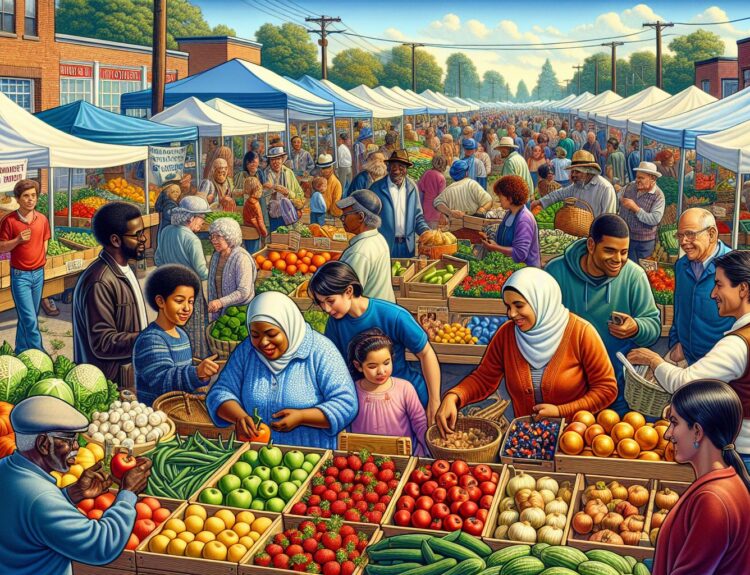I’ve always been fascinated by the green patches nestled between the concrete jungles of our cities. Community gardens and urban agriculture initiatives are not just about growing plants; they’re about cultivating communities and sustainable practices in the heart of urban areas. They’re a breath of fresh air, quite literally, amidst the hustle and bustle of city life.
These gardens are more than just a place to grow food. They’re a hub for education, social interaction, and environmental stewardship. I’ve seen firsthand how they can transform spaces and people alike, fostering a sense of belonging and responsibility towards our planet. Let’s dive into the world of urban greenery and discover the impact these initiatives are making in cities around the globe.
The Rise of Community Gardens
As I’ve been exploring the world of urban greenery, I’ve noticed a significant trend that’s reshaping the landscapes of cities around the globe: the rise of community gardens. This movement isn’t just about a few plants here and there; it’s a fundamental shift in how we view our urban spaces and our role within them.
Community gardens have been blossoming in neighborhoods that were once dominated by concrete and asphalt. It’s as if communities collectively decided to reclaim spaces, turning unused or underutilized land into vibrant areas of growth and learning. The beauty of it? Anyone can participate. Whether you’re a seasoned gardener or someone who’s never touched soil, there’s a place for you. These gardens have become inclusive spaces that welcome diversity, fostering connections among people from all walks of life.
Here’s a bit of context to illustrate just how rapidly this movement is growing:
| Year | Number of Community Gardens in Major Cities |
|---|---|
| 2000 | 1,200 |
| 2010 | 2,500 |
| 2020 | Over 4,000 |
This exponential growth isn’t just happening in one region or country; it’s a global phenomenon. Urban agriculture initiatives are sprouting up everywhere, driven by a collective realization of their manifold benefits. From reducing carbon footprints to enhancing local biodiversity, the advantages are undeniable.
But it’s not just about the environmental benefits. Community gardens are teaching us valuable lessons in sustainability and responsible stewardship of our planet. They serve as hands-on classrooms where children and adults alike learn about the importance of locally grown food and the nuances of ecosystem management.
Moreover, these gardens are doing wonders for mental health and well-being. There’s something inherently therapeutic about connecting with the earth, nurturing plants, and watching them grow. It’s a form of natural healing that many urban dwellers didn’t realize they were missing until they got their hands dirty.
In the conversations I’ve had with people involved in these initiatives, there’s a resounding sense of pride and accomplishment. Transforming a barren lot into a flourishing garden is no small feat. It requires collaboration, patience, and a lot of hard work, but the rewards extend far beyond the harvest. Community gardens are cultivating a sense of belonging and shared purpose, reminding us of the power of coming together to make a positive impact on our world.
Benefits of Urban Agriculture Initiatives
When I first ventured into the world of urban agriculture, I was amazed at its varied benefits. Not only do these green spaces inject a dash of nature into our concrete jungles, but they also offer profound advantages that resonate on economic, social, and personal levels.
Economic Growth and Food Security
At the forefront, urban agriculture initiatives contribute significantly to local economies and food security. By fostering local food production, these gardens reduce the need for food transportation, which in turn lowers food prices and minimizes carbon emissions. Here are some intriguing facts:
| Aspect | Benefit |
|---|---|
| Food Cost | Decreases due to reduced transportation and local growing |
| Employment | Increases as these gardens often require managers and caretakers |
| Carbon Footprint | Reduces due to lesser dependency on imported foods |
Social Cohesion and Community Empowerment
Beyond economics, the social impact of community gardens and urban agriculture is equally significant. These initiatives serve as community hubs where people from diverse backgrounds come together, forging bonds over shared tasks. This sense of community builds more cohesive neighborhoods where people feel a pronounced sense of belonging and mutual responsibility.
Mental and Physical Health Benefits
Another aspect I’ve personally witnessed is the improvement in mental and physical health. Gardening is therapeutic. It reduces stress, provides a form of mild exercise, and connects individuals directly with nature, offering a peaceful retreat from the bustle of city life. Moreover, access to fresh, organic produce contributes to a healthier diet, enhancing overall well-being.
Educational Opportunities
Urban agriculture is a living classroom. It provides hands-on learning experiences in sustainable practices, agriculture, and environmental conservation. Schools and community groups often visit these sites, gaining insights into the origins of food and the importance of ecological harmony.
Engaging in urban agriculture initiatives has reshaped my understanding of community involvement and its myriad benefits. It’s an empowering journey that cultivates not just gardens, but healthier, more sustainable, and connected communities.
Creating Sustainable Urban Spaces
When I first stepped into a community garden nestled between towering apartment buildings, it was like walking into a hidden oasis. The lush greenery and the gentle hum of urban nature in action was a stark contrast to the concrete jungle surrounding us. This experience opened my eyes to the incredible potential of community gardens and urban agriculture initiatives in creating sustainable urban spaces.
One of the most immediate benefits I’ve noticed is how these green spaces help combat the urban heat island effect. Cities are known for being several degrees warmer than their rural counterparts, thanks to buildings, roads, and other infrastructure absorbing and re-emitting the sun’s heat more than natural landscapes. Community gardens and urban farms act as pockets of cool, helping lower temperatures in densely populated areas. This not only makes cities more comfortable to live in but can significantly reduce energy consumption by lowering the need for air conditioning.
Moreover, these initiatives often utilize sustainable gardening practices, such as composting and water harvesting, which contribute to a healthier environment. Composting organic waste reduces methane emissions from landfills, turning potential pollutants into nutrient-rich soil. Water harvesting techniques, whether through rain barrels or more sophisticated systems, mitigate stormwater runoff, decreasing the burden on city drainage systems during heavy rains.
On a broader scale, urban agriculture can enhance biodiversity in cities. By introducing a variety of plants and creating habitats, these gardens attract beneficial insects, birds, and other wildlife, increasing the ecological richness of urban areas. I’ve watched gardens become lively ecosystems where educational conversations about native species and pollinators naturally spring up among community members.
It’s also hard to overlook the role of these green spaces in fostering sustainable food systems. By producing food locally, urban farms lessen the reliance on long-distance food transportation, reducing carbon emissions. This local production also ensures fresher produce, often harvested the same day it’s consumed, leading to less food waste. The below table illustrates the carbon footprint reduction potential from local compared to long-distance food systems:
| Food Source | Average Carbon Footprint (CO2e/kg) |
|---|---|
| Local Production | 0.5 – 1.5 |
| Long-Distance Transport | 5 – 10 |
Community Engagement and Social Impact
When I first stepped into the realm of community gardens and urban agriculture, I was primarily attracted by the promise of fresh produce and a bit of tranquility in the heart of the city. But what I discovered ran much deeper than that. These green spaces are more than just plots of land where vegetables grow; they’re vibrant hubs of community engagement and social interaction.
One of the most remarkable transformations I’ve witnessed centers on social cohesion. Community gardens bring together people of diverse backgrounds, cultures, and ages, fostering a rare sense of unity in urban settings. Here’s a breakdown of the impact I’ve seen:
- Learning and Sharing: Every visit becomes a learning opportunity. From experienced gardeners sharing their wisdom with novices to cultural exchanges over traditional gardening techniques, the knowledge shared is invaluable.
- Youth Engagement: These gardens provide a safe space for young people to learn responsibility, understand the value of hard work, and connect with nature, which is increasingly rare in urban life.
Moreover, the social impact extends beyond the fences of these gardens. They serve as models for collaborative problem-solving and collective action. Community gardens have played pivotal roles in revitalizing abandoned or under-used urban lots, turning them into productive and beautiful spaces that serve the community.
The contribution to mental well-being cannot be overstated. In my conversations with fellow gardeners, the therapeutic value of tending to a garden comes up frequently. The combination of physical activity, being in nature, and the sense of accomplishment in growing your own food contributes significantly to reducing stress and anxiety.
One aspect that I find particularly inspiring is how these initiatives provide a platform for advocacy and education on environmental issues. Through workshops and day-to-day activities, people become more informed about sustainable practices, the importance of local food systems, and the challenges of food security. This awareness sparks a ripple effect, driving positive change that extends well beyond the garden itself.
What’s equally compelling is the role of urban agriculture in promoting food justice. By providing access to fresh, nutritious produce in food deserts—areas lacking in affordable, healthy food options—these gardens address inequalities in food access and contribute to healthier communities.
Global Impact and Future Trends
As I’ve explored the local influences of community gardens, it’s just as essential to recognize their global footprint. Around the world, urban agriculture has started to reshape cities, proving that green spaces and farming can flourish amidst concrete jungles. From rooftop farms in New York City to the sprawling vegetable gardens in Tokyo’s residential areas, these initiatives have demonstrated their versatility and adaptability in various urban settings.
One of the most compelling aspects of this movement is its tangible impact on food security. In cities where access to fresh produce can be limited, community gardens offer a local solution that reduces the need for food transportation, consequently lowering carbon emissions. For instance:
| City | Percentage of Locally Grown Food Supplied by Urban Agriculture |
|---|---|
| New York | 5% |
| Tokyo | 25% |
| Toronto | 10% |
These figures highlight the significant role urban agriculture plays in feeding city populations. As the global population continues to urbanize, these gardens aren’t just nice-to-have; they’re becoming essential components of urban planning strategies.
Looking ahead, I see technology playing a pivotal role in the growth of urban agriculture. Innovations like vertical farming and hydroponics are opening up new possibilities, allowing for year-round production in smaller spaces. These methods not only increase yield but also use less water and no soil, which is a game-changer for cities looking to become more sustainable and resilient against climate challenges.
Moreover, as community engagement grows, I’ve observed an increasing interest in educational programs centered around urban agriculture. Schools and community centers are beginning to integrate garden-based learning into their curriculums, teaching children about the importance of sustainability and where their food comes from. This shift not only promotes healthier eating habits but also instills a sense of responsibility and connection to the environment from a young age.
Finally, there’s a rising trend in using urban agriculture as a tool for social inclusion. Gardens are becoming spaces where people from diverse backgrounds and ages come together, breaking down social barriers and fostering a sense of belonging. This aspect is especially vital in cities where the fast-paced lifestyle can often lead to isolation and disconnection.
As fascinating as these developments are, it’s clear that urban agriculture’s potential is only just starting to be realized. With continued innovation and community commitment, there’s no telling how far this movement can go.
Conclusion
I’ve always believed that the greenest patches in our concrete jungles hold the key to not just a healthier plate but a united community. Seeing cities like New York and Tokyo embrace urban agriculture has been nothing short of inspiring. It’s clear that with a bit of innovation and a lot of community spirit, we can turn rooftops into gardens and empty lots into food havens. The advances in technology, be it vertical farming or hydroponics, are paving the way for us to face climate challenges head-on while keeping our bellies full and our planet green. More so, I’m thrilled about the educational programs sprouting up, teaching our kids the value of sustainability and healthy eating. It’s heartwarming to see urban agriculture not just feed us but bring us together, bridging gaps across communities. I’m optimistic about the future of urban agriculture. With continued innovation and community engagement, I’m convinced we’re on the brink of a greener, more inclusive urban landscape. Let’s keep growing, not just our gardens but our community bonds too.






